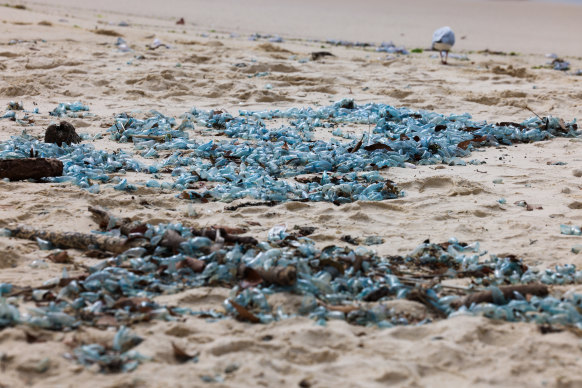By Nick Newling
As Sydneysiders flock to the coast for what is set to be the warmest day since March, an armada of bluebottles has been washed up on the states’ beaches from The Entrance to Thirroul, sailing in on warm north-easterly winds.
Kevin Crick, president of the Woonona Surf Lifesaving Club on the NSW South Coast, said he’s used to seeing bluebottles “appearing out of nowhere”, but that the timing of this week’s arrival is odd.
“Usually, we don’t cop ’em this early,” Crick said. “They’re prolific, they’ll always turn up – it’s just unusual for that many to be here so early.”
Mass arrivals, or “blooms”, of bluebottles – a type of stinging man o’ war – happen when favourable weather and reproductive conditions converge each summer, the last major event being in 2021.
After a pattern of south-easterly winds earlier in the week, a midday change on Saturday brought about north-easterlies, which are favourable for bluebottles reaching Sydney’s beaches.

Bluebottles washed up on Sydney’s Tamarama beach. Credit: Edwina Pickles
Bluebottles have been spotted at several beaches along Sydney’s coastline, and ocean pools Wylie’s Baths and McIver’s Ladies Baths have warned swimmers.
The bloom comes with Sydney expecting a high of 32 degrees on Sunday, with a “very-high” UV index of nine. Jake Phillips, a meteorologist at the Bureau of Meteorology said that the forecast showed a “fairly warm week overall” with the temperatures falling slightly before scraping 30 again on Wednesday and Thursday.
“The long-term average [for this time of year] is 23.7 degrees,” he said. “If we reach our forecast maximum we are getting well above average, but not record-breaking territory.”
What is a bluebottle, and how do they sting?
The common bluebottle found in Australia is the Physalia utriculus.
Its blue, balloon-like sail sits above the water and is attached to a long tentacle extending below.
This tentacle is covered in stinging cells called nematocysts. When this touches the skin, it reacts by injecting a small amount of a toxin that causes irritation and can be quite painful. Sometimes it can get caught in someone’s mouth or hair and wrap around a leg or arm.
What should you do if you are stung?
Surf Life Saving Australia’s Beach Safe App, which provides information on hazards at each beach including stingers, says:
- Wash off any remaining tentacles with seawater, or pick off with your fingers (they can’t usually sting through the tough skin on your fingers);
- Immerse the patient’s sting in hot water (no hotter than can be easily tolerated);
- If local pain is not relieved or immersion facilities are not available, applying cold packs or wrapped ice is also effective.
What shouldn’t you do?
Surf Life Saving says lifeguards are often amused and entertained by the many strange and bizarre treatments people try to relieve the pain of the stingers.
For example, urinating over the sting was “gross, and doesn’t work anyway,” it said. Pouring soft drink over a sting just makes it itchy.
with Julie Power